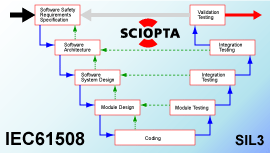
The SCIOPTA real-time kernel is in the final stages of certification by TÜV Germany to the IEC 61508 standard at Safety Integrity Level 3 (SIL3).
The first SCIOPTA safety certified kernel will be available for the ARM®7/9 target platforms. Support for other processors such as PowerPC, ColdFire® and XScale is planned.
IEC61508 is an international standard focusing on safety-related systems that incorporate electrical, electronic and/or programmable electronic (E/E/PE) instruments and devices.
Initially mainly used in the automation and process control industry, IEC61508 is more and more accepted for applications in other industries including automotive and medical where safety and reliability are paramount.
SCIOPTA safety documentation includes the Safety Manual, the TÜV IEC61508 SIL3 certificate and the TÜV certification report. All other certification documents such as Safety Requirement Specification, Design Specifications, Test Specifications, Safety, Validation and Verifications Plans are available upon request.
Technology
SCIOPTA 61508 is a pre-emptive multi-tasking high performance real-time kernel which includes many built-in safety features.
As a direct message-passing kernel, SCIOPTA is very well suited to be used in safety-critical applications.
No Shared Memory
Shared memory is the standard method for interprocess communication in traditional real-time operating systems. The user is fully responsible to protect shared memory with semaphores and to associate semaphores with data areas and types.
There is no need for shared memory in a SCIOPTA system. Direct message passing is safer. All data is encapsulated inside messages and the kernel protects message data by controlling ownership.
Safe Memory Management
Processes can be grouped together into SCIOPTA modules. Each module can have up to 128 pools to hold SCIOPTA messages.
SCIOPTA supports a module friend concept. Friendship between modules can be defined and configured by the user. This friendship setting defines if messages are copied or not when they are crossing module boundaries.
Modules and pools can be located in the same or in different memory segments. With the SCIOPTA Memory Management System (SMMS) and a Memory Management Unit (MMU) full memory protection can be achieved.
